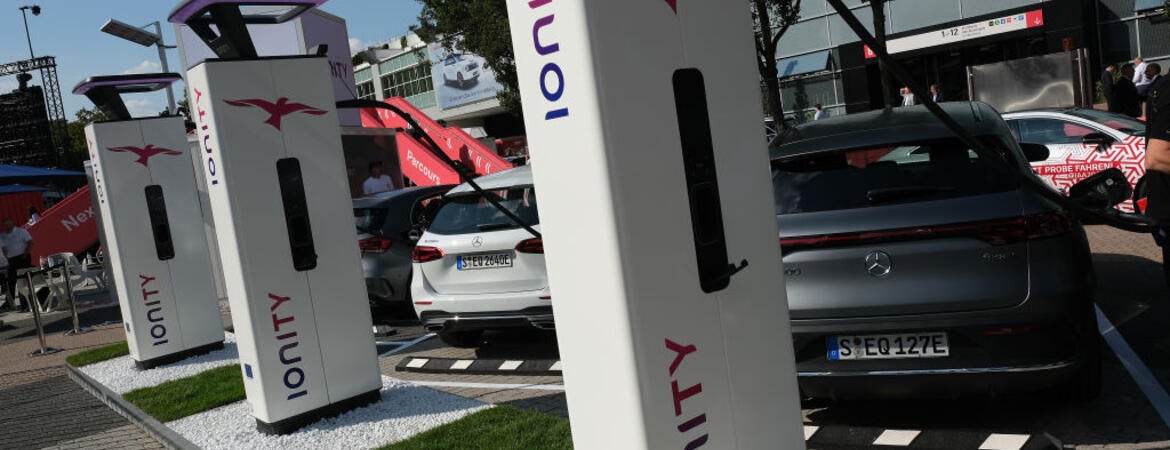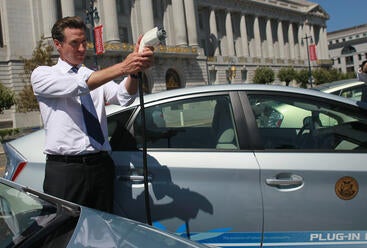
Proposition 30 would call for Californians earning more than $2 million per year to help fund zero-emission vehicle purchases and infrastructure, and — to a lesser extent — to fund wildfire response and prevention. It would generate between $3.5 to $5 billion annually by taxing the personal incomes of 35,000, or .2% of Californians who account for 30% of the state’s taxable income. Half of the funding dedicated to zero-emissions vehicles, or ZEVs, would go toward rebates for low-to-middle-income residents who buy ZEVs.
The proposition would require 50% to pass on Nov. 8. In a short time, polling has shifted dramatically on Californians’ support for the measure, from 55% in September to 41% in the latest poll from the Public Policy Institute of California. Much of that may be due to opposition to the measure from critics including Gov. Gavin Newsom. Newsom and others belief Lyft, the rideshare company, would benefit disproportionately from the electric-vehicle, or EV, infrastructure funding, because it would help the company reach a state-mandate that electric cars go emission-free by 2030.
We asked three UCR experts, Bruce Babcock from the School of Public Policy, political scientist Shaun Bowler, and Arun Raju from the Center for Environmental Research and Technology to help voters sift through mountains of "Yes" and "No" Prop 30 mailers.
Q: As recently as two months ago, there was widespread support for Prop 30, and now only 41% of polled voters are in favor of it. What happened?
Babcock: Two months ago people had not even heard about Prop 30. Then the ads started and Governor Newsom came out against it.
There are a number of unanswered questions that should be answered before voting yes. Is our current plan of building out infrastructure adequate given the expected uptake of electric cars? California state agencies have been pretty good so far with transition, so I trust them more than backers of this proposition. If we do need to invest more in infrastructure, do we need a new revenue stream from Prop 30? I believe a little more thought about unintended results should be given to this topic. And that is how the legislature is supposed to operate. So leaving it to the legislature is the way to have a more thoughtful consideration of the situation.
Bowler: Newsom’s opposition is a signal that at least some Democrats can oppose this proposal. And that moves the issue beyond a simple partisan one. Things are easier for voters if the D's are all on one side of an issue and R's on the other. Newsom’s intervention has, in a sense, made the issue more complex for voters. That alone might be enough to tip a few people to vote “no,” which is a common response by voters when they are not sure which way to vote.
Q: The rideshare company Lyft has contributed 95% of funding, or $45 million, to the “Yes on 30” campaign. Forty-four people have contributed more than $100,000 to the “No on 30” campaign. Gov. Gavin Newsom and others have alleged Lyft would benefit disproportionately from construction of EV infrastructure. Is the Lyft issue obfuscation from those who realize millionaires’ tax woes do not garner much sympathy?
Babcock: Clearly millionaires do not garner sympathy, but perhaps they should in this case. California already has the highest top rate in the country. And California gets more than half of income tax from top earners. Many Californians pay zero state income taxes. While California’s climate and access to highly educated workforce is attractive to top earners, paying a top rate of 15.5% on top of a 37% federal rate clearly creates an incentive to move to a no-income tax state. California voters already extended the previous “temporary” tax surcharge on high earners so Prop 30 should be viewed as a permanent increase if it passed.
Bowler: It’s a clever move by Lyft. Generally speaking their drivers are lower-income and would need help to buy these cars. This is a way to get someone else to help pay for those new cars. The donation is a large one and does suggest they think they will benefit a lot from having this law passed. It is such a big sum that one might think if Lyft is spending $45 million on an election campaign, they could have offered that money to Lyft drivers as incentives to help buy electric cars this year, or maybe should have a program in place.
Q: The new, highest state tax rate would be 15.05%, the highest tax rate in the country, and well above the national average of 5.5%. is there legitimate concern this measure could push California’s top earners out of state?
Bowler: Millionaires are not a popular group. And that makes it “easy’ in some senses. As the tax rate keeps increasing, then people may decide to leave. But while income taxes may be lower elsewhere, property taxes are higher. So how easy it is to actually move and how much benefit there is in moving takes a bit of deciding.
The state tax base relies on high earners, which does make the state’s tax base volatile. Putting to one side the questions of "soaking the rich" or whether the rich will move, there is a broader question about whether the state should develop other sources of revenue in the interests of budget stability. This proposal does not help that.
Q: The state is investing $10 billion to electrify vehicles and build the infrastructure required to support them. The 2021 federal Infrastructure Investment and Jobs Act provides $384 million for California EV infrastructure. Are the tax dollars Proposition 30 would generate also needed?
Babcock: The state is awash in revenue. Why do we need to raise taxes now? We are giving back lots of money to taxpayers via the gas tax rebate. Perhaps, Californians do not want to send even more money to Sacramento, even if it is money earned by millionaires.
Q: California plans to phase out the sale of gasoline-powered passenger vehicles by 2035. There are about 73,000 public and shared EV chargers in the state, with another 123,000 planned. There are more than one million electric vehicles registered in California. Is it feasible that California will have the EV infrastructure needed by 2035?
Raju: There are aggressive plans to expand the infrastructure, but I don’t think there is a clear answer yet. The National Electric Vehicle Infrastructure, or NEVI, program, part of the Bipartisan Infrastructure Law, will install 864 charging ports at 143 sites in California across select "corridors." There are also a number of other public/private efforts to make sure that the state can meet the demand.
Q: The transportation sector is responsible for 80% of smog-causing pollutants and is a significant source of toxic air contaminants that directly impact community health, the environment, and the economy. Can you place in context the urgency of California’s shift to EVs?
Raju: A significant amount of the criteria pollutants and toxics are produced by the medium/heavy duty vehicles (trucks) so it is critical to ensure a ZEV transition in that sector as well.
Editor's note: There are about 30 million registered vehicles in California. Of those, about two million are medium- or heavy-duty trucks. But those trucks, many of them diesel, are responsible for 70% of the smog-causing pollution. The 2035 California combustion engine phase-out does not include these trucks. Newly proposed rules from the Air Resources Board would ban manufacturers from selling new fossil-fueled medium- and heavy-duty trucks by 2040. The first public hearing on those rules was held Oct. 27.




